

Teaching Questioning Skills to Arm Students for Learning - Work in Progress. In the earliest part of my career, I wrote full procedural lesson plans that spelled out to the letter the questions I would ask AND the answers I considered correct.
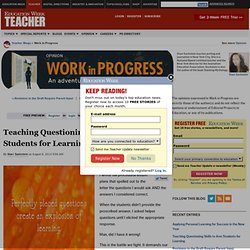
When the students didn't provide the proscribed answer, I asked helper questions until I elicited the appropriate response. 5 Powerful Questions Teachers Can Ask Students. My first year teaching a literacy coach came to observe my classroom.

After the students left, she commented on how I asked the whole class a question, would wait just a few seconds, and then answer it myself. New Classroom Questioning Techniques for the Best Year Ever. Teachers ask 400 questions a day -- 70,000 a year, according to The Guardian.
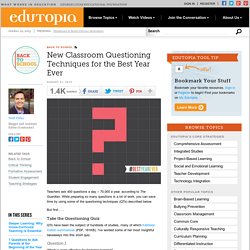
While preparing so many questions is a lot of work, you can save time by using some of the questioning techniques (QTs) described below. But first . . . New Research: Students Benefit from Learning That Intelligence Is Not Fixed. Arten Popov Teaching students that intelligence can grow and blossom with effort – rather than being a fixed trait they’re just born with – is gaining traction in progressive education circles.
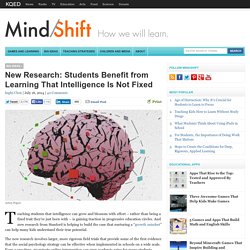
And new research from Stanford is helping to build the case that nurturing a “growth mindset” can help many kids understand their true potential. The new research involves larger, more rigorous field trials that provide some of the first evidence that the social psychology strategy can be effective when implemented in schools on a wide scale. Even a one-time, 30-minute online intervention can spur academic gains for many students, particularly those with poor grades. The premise is that these positive effects can stick over years, leading for example to higher graduation rates; but long-term data is still needed to confirm that. Carol Dweck: The Effect of Praise on Mindsets.
Growth Mindsets: Creating Motivation and Productivity. The key to success and achieving our goals is not necessarily persistence, hard work and focus.
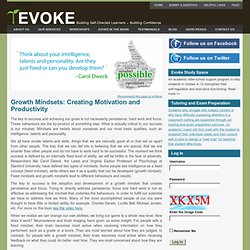
These behaviours are the by-product of something else. Tools for metacognition. Metacognition is an important part of intentional learning, since it involves actively thinking about what you know, what you don’t know, and how you can get better at knowing and applying what you know.
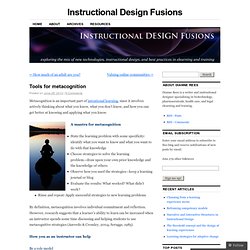
A mantra for metacognition State the learning problem with some specificity: identify what you want to know and what you want to do with that knowledgeChoose strategies to solve the learning problem—draw upon your own prior knowledge and the knowledge of othersObserve how you used the strategies—keep a learning journal or blogEvaluate the results: What worked? What didn’t work? Rinse and repeat: Apply successful strategies to new learning problems By definition, metacognition involves individual commitment and reflection.
Smart Strategies That Help Students Learn How to Learn. Teaching Strategies Bruce Guenter What’s the key to effective learning?
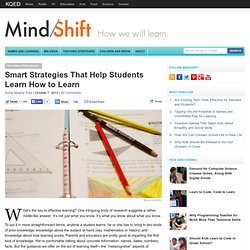
One intriguing body of research suggests a rather riddle-like answer: It’s not just what you know. It’s what you know about what you know. To put it in more straightforward terms, anytime a student learns, he or she has to bring in two kinds of prior knowledge: knowledge about the subject at hand (say, mathematics or history) and knowledge about how learning works. Ten Takeaway Tips for Teaching Critical Thinking. Suggestions from educators at KIPP King Collegiate High School on how to help develop and assess critical-thinking skills in your students.
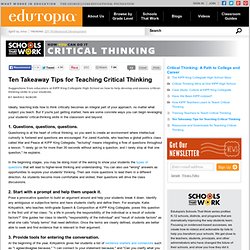
Ideally, teaching kids how to think critically becomes an integral part of your approach, no matter what subject you teach. But if you're just getting started, here are some concrete ways you can begin leveraging your students' critical-thinking skills in the classroom and beyond. 1. Questions, questions, questions. Questioning is at the heart of critical thinking, so you want to create an environment where intellectual curiosity is fostered and questions are encouraged. In the beginning stages, you may be doing most of the asking to show your students the types of questions that will lead to higher-level thinking and understanding. Why the Growth Mindset is the Only Way to Learn. Top Ten Tips for developing a Growth Mindset in your Classroom. Be Critical.
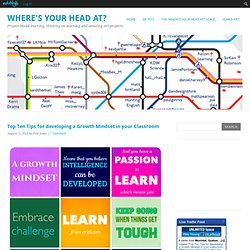
Students should expect and welcome criticism. They must also be given the opportunity to act on any criticism or critique. This will allow students to realise that through improving their work and responding to feedback, they can be better than they were. For this to happen, the culture of improvement needs to feel completely normal. As teachers, we also need to think about how and when we give feedback. Provide elements of choice. Imagine if every classroom, every teacher instilled this culture within your school.
Author: Pete Jones. Developing a growth mindset in the classroom. There’s a free info graphic version of this article.
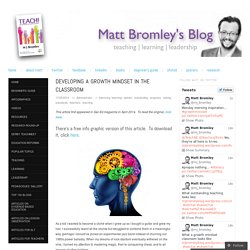
To download it, click here. Becoming a growth mindset school. The idea of becoming a growth mindset school has been over a year in the making. Our Headteacher bought each member of SLT a copy of Mindset for Christmas, and it was the main agenda item at our annual senior team conference. Today I launched the idea of becoming a growth mindset school to all staff at our INSET day.
This is the basis of the presentation I did. Our INSET session was for all staff – teaching, support, administrative, catering, site, network, technicians – everyone!